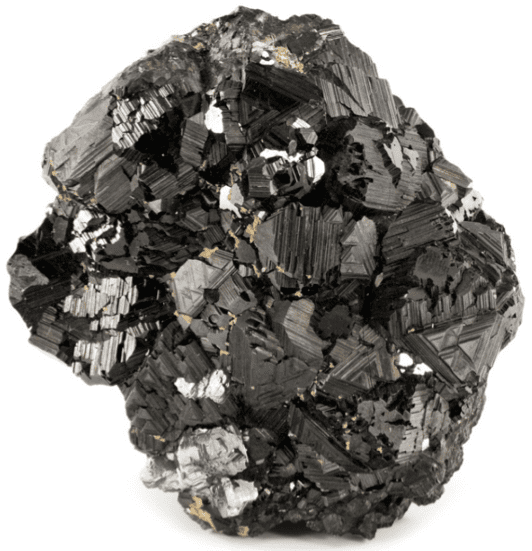Magnetite Iron Oxide
Introduction
Magnetite is a naturally occurring iron oxide with the chemical formula Fe3O4. It is mined from several deposits worldwide and although most is used to make iron and steel, the many special properties of magnetite have led to several other applications including as a filler for plastics and coatings. In many ways, magnetite is the opposite of common mineral fillers. An overview is presented here. More detail can be found in the articles and encyclopedia chapter mentioned below.
- Appearance: Black, shiny, lustrous
- Density: High, 5.2 gcm-3
- Thermal conductivity: High
- Electrical conductivity: Semi-conductive (ρ 45 Ωm)
- Radiation blocking: Very good (neutrons and x-rays)
- Specific heat capacity: Exceptionally high

Applications
Dense Plastics
In many fields, magnetite is used as ballast, to add mass. Common examples are counterweights and off-shore oil platforms. Likewise, it is added to plastics like polypropylene, polyamides (nylons) and polyethylene, to give a dense compound. Sometimes the density is desirable to add heft and the feeling of high quality. In other cases, the added density is useful for sound damping, one of the most common uses in plastics, where it is used by several major automotive companies. Loadings of 80 weight% or higher are common and composite densities of around 3.0 gcm-3 are easily possible. Barium sulfate is also used as a dense filler. Tungsten is used when very high densities are demanded and high cost can be accepted.
Ferrofluids and magnetorheological fluids
In the 1960s NASA discovered that by grinding down natural magnetite in oil to an extremely fine particle size, one obtained a fluid that responded to a magnetic field. They patented the new type of material, which has become important for loudspeakers, active vibration damping in cars and even in military applications like silent fluid bearings for submarines.

For aesthetics
Magnetite is used as an special effect pigment. Coarser grades are used where the angular particles reflect light to give an attractive appearance to thermoplastics and thermoset materials.
As a tracer
In some instances, it is important to be able to detect plastic. Normally, plastic does not show up in an x-ray or using a metal detector. By adding magnetite as a filler in loadings of 10 weight % or even lower, it is possible to make the plastic detectable by both methods. Example applications are in anti-counterfeiting and in food contact zip ties so they can be detected if they fall into the food product by mistake. For that latter application a very pure, food contact approved type is needed.
Radiation blocking
Magnetite has been used dense aggregate in concrete for decades. Sometimes just for the added density but often for its radiation blocking properties. Hospital radiology units used to be built with extremely thick walls where the concrete would block the x-rays, protecting doctors and patients in adjacent rooms. Nowadays, a preferred method is to add magnetite to the concrete thereby allowing the walls to be 40% thinner but with equivalent radiation blocking ability and the same principal can be applied in plastics.
For microwave or induction heatability
Plastics are microwave transparent and do not heat by induction because they are electrical insulators without any magnetic properties. Magnetite is added to polymers to allow them to be heated either by microwaves or using induction.
Heat storage
There are applications requiring the storage and release of heat. Magnetite is very unusual in having a volumetric specific heat capacity far higher than most solids. It is able to store, the release, more heat per unit volume than metals, concrete, plastics or other minerals.
Magnetism
As the name implies, magnetite has magnetic properties. Lodestone is a natural form of magnetite that is magnetised, that is, it is a magnet and can attract ferromagnetic materials like iron, nickel and cobalt. Lodestone is very rare however and almost all natural magnetite is not magnetic at all. It is instead ferrimagnetic meaning that although it can be attracted to a magnet, it is not itself a magnet. By putting magnetite into plastic, the plastic article can be attracted to a magnet, for example to remove plastic pieces that may be knocked loose from machinery or food processing equipment. Or, one could make a magnetic lid for a perfume bottle. Magnetite is used as a filler in paint so that you can stick magnets to your walls. Surprisingly, although black in color, magnetite is a weak pigment so one can add colored pigment to overcome the black and thereby achieve a wide range of hues.
Conclusion
Magnetite is a multi-functional filler for plastics. Although marketed for the last twenty years, it is still not widely known. This article and the information below serve, hopefully, to increase awareness of the specialty filler and what it can do. Phantom Plastics has assembled what is probably the world’s largest magnetite information repository to help customers develop new applications.
Need a Magnetite Expert?
Further reading
Magnetite (chapter)
C. DeArmitt, Encyclopedia of Polymers and Composites, Springer 2014.
Magnetite: exploring the multi-functional filler
C. DeArmitt, Compounding World, August 2015.
Fancy Fillers
C. DeArmitt & R. Rothon, Plastics Additives & Compounding (Elsevier), 7, 4, 28-31 (2005).